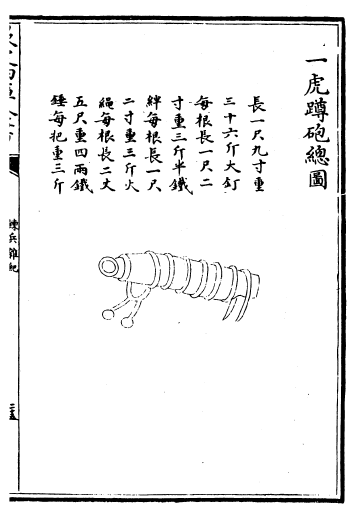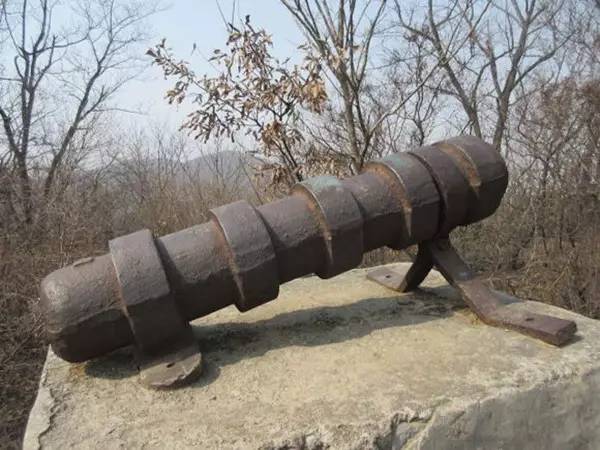 |
| Drawing of a Hu Dun Pao, from 'Lian Bing Za Ji (《練兵雜紀》)'. |
Hu Dun Pao (虎蹲砲, lit. 'Tiger crouching cannon') is a type of iron cannon widely used by the Ming army. It is perhaps the weapon that best represents the Chinese artillery doctrine of the Ming period.
A typical Hu Dun Pao has a length of one
chi nine
cun, and weights thirty-six catties. It has bore diameter of two
cun, usually loaded with six to eight
liang of powder, fifty large lead or iron shots or one hundred smaller ones, and a large stone ball (later replaced by iron ball). For its size, Hu Dun Pao is an extremely powerful cannon, yet it is light enough to be carried by one or two men. Hu Dun Pao has a characteristic bipod that enables it to be staked firmly to the ground, so that the cannon will not jump violently due to recoil. The bipod, combined with the compact size of the cannon, allows multiple Hu Dun Pao to be fired in close proximity to each other, potentially increase the firepower manyfold.
 |
| A very large Hu Dun Pao at Wolongtai Great Wall section, Xinyang, Henan, China. |
Hu Dun Pao was designed by general Qi Ji Guang (戚繼光) to replace the aging
Er Jiang Jun (二將軍, lit. 'Second general'),
Ying Zi Pao (櫻子砲, lit. 'Cherry seed cannon'),
Du Hu Pao (毒虎砲, lit. 'Vicious tiger cannon') and
Wan Kou Pao (碗口砲, lit. 'Bowl-muzzle cannon') of the early Ming Dynasty. Qi Ji Guang criticised these early cannons for being either too weak, too bulky, or have uncontrollable (and very dangerous) recoil, and designed Hu Dun Pao specifically to address these issues. In Qi Ji Guang's army, one Hu Dun Pao was issued to every fifty infantry and every forty-five horsemen. Later during the
Imjin War, heavy variant of Hu Dun Pao was employed as siege cannon and naval gun, although it was not particularly suitable for either role, as its arc of fire was too high to reliable hit enemy wall, and recoil too powerful for Chinese warships (the recoil would damage the ship).
Although a very successful design, the limitation of Ming Dynasty firearm technology was clearly evident on the Hu Dun Pao. The Chinese never developed grapeshot and canister shot, thus powder, sabot and shots have to be loaded separately into the barrel, greatly reducing rate of fire as well as range and firepower (due to larger windage). Besides, Chinese did not develop wheeled gun carriage on their own until very late (they adopted gun carriage from the Europeans, and later devised several indigenous designs for their newer cannons, but its use was uncommon), which severely affected the size, mobility and battlefield manoeuvrability of their artillery. Chinese cannon had to be made very light to be transportable at all, yet the advantage of lighter weight could not be fully utilised because it had to be staked to the ground.


Hi. I like your blog. Do you happen to have information on the banner designs that the Ming used, especially during the Imjin War? Are they similar to the Koreans who used the guardian beasts (Azure Dragon, White Tiger, Black Turtle, Vermillion Bird)?
ReplyDelete@Jayson
ReplyDelete(You double posted so I removed one of the comment, since both comments are identical =D )
Glad you like my blog =).
There are plenty of (drawing of) Ming banners available in military treatises, but mostly in black & white. The Ming certainly used the four Guardians (five to be precise, they had a 'Rising Snake' as central Guardian/banner) as their military banner, along with many, many other such as Taoist sages, constellations, or Chinese zodiac.
The most appropriate banners for the Imjin War period should be the banners from Qi Ji Guang's manual.
A good place to start:
http://tieba.baidu.com/p/3256401566
Thanks. Will check that out.
ReplyDeleteare you Chinese 春秋戰國???
ReplyDeleteYes, why?
DeleteDid Qi Jiguang design the gun from scratch? Needham claims it was already in existence in the mid 14th century, apparently being present in the Huolongjing (not sure which version). Is this true or is he mistaken?
ReplyDeleteYes, I mean small cannon of that size already exist, Qi Jiguang just have to design the bipod for it.
DeleteAlso, although the book contains records of early weapons, almost all editions of Huolongjing dates no earlier than sixteenth century.
Yeah I was just wondering what exactly he did because the depiction in the Huolongjing (assuming Needham's picture is correct) seems basically identical to the 16th century examples. The weiyuanpao also I guess would be a similar case.
DeleteBut yeah I've had suspicions about the Huolongjing precisely for these reasons.
@Eirevek
DeleteIndeed it's very difficult to tell whether a weapon recorded in Huolongjing is an early weapon, it's improved/modernised iterations, or a relatively recent addition.
Weiyuanpao is an even later design than Hudunpao.
Yeah that's really unfortunate since we don't have much in the way of comprehensive sources for that period but such is a historian's life heh
DeleteThankfully we have other sources and surviving guns.
In the book 《练兵实纪》of Qi Jiguang, he mentioned the other things that comes with Hu dun pao, which is: 药升 (I guess you use this to put the powder into the cannon),
ReplyDelete木送 (no idea). Do you know what they are?
药升 is gunpowder scoop, 木送,also known as 送子木錘 is rammer/ramrod.
DeleteThanks for your help.
Delete